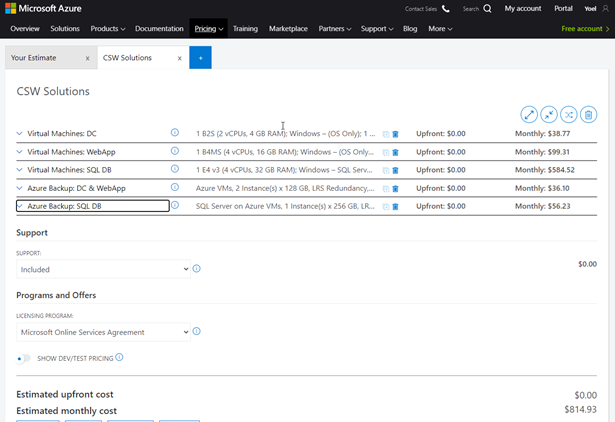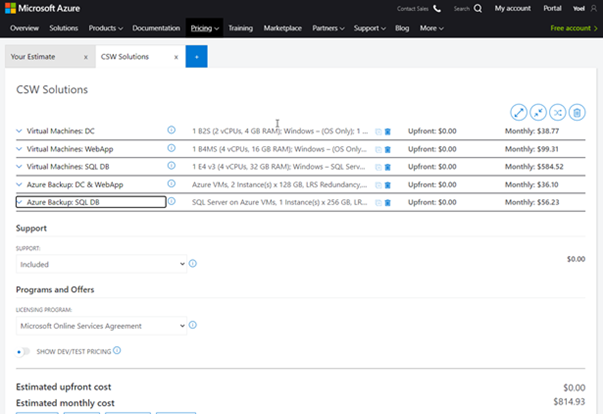Co-founder and a Managing Partner at CSW Solutions. You can find Yoel on LinkedIn and Twitter.
Migration from on-premises to the Azure cloud is a complex process. The determination of costs and benefits for a migration require a strategic, all-encompassing approach. It is therefore, critical to understand and account for all of the variables involved in the project.
While there are many factors to consider when considering the migration to the Azure cloud, one of the most important is cost and calculating the actual cost of a migration is more difficult than it appears. In this post we will discuss the best way to do this in three steps.
 Before you decide on a cloud migration, you will need to have a thorough understanding of your current on-premises infrastructure. An infrastructure audit is the first step, as it will reveal how much you are currently paying for IT and what your new Azure cloud environment may look like. This audit will be the baseline for your cloud migration to assist in calculating potential costs of the cloud resources you will use.
Before you decide on a cloud migration, you will need to have a thorough understanding of your current on-premises infrastructure. An infrastructure audit is the first step, as it will reveal how much you are currently paying for IT and what your new Azure cloud environment may look like. This audit will be the baseline for your cloud migration to assist in calculating potential costs of the cloud resources you will use.
The audit takes a comprehensive approach, accounting for the total cost of using and maintaining your current on-premise IT investment over time, rather than just the cost of infrastructure. For this calculation we will take into account, both direct and indirect costs.

There are two types of direct costs that need to be reviewed. First is the cost of your hardware and software and the second type is operational cost. The cost of hardware and software is relatively easy to collect and will answer the question of how much you pay (or have paid) for the following:
While collecting this data, you can also figure out how much network bandwidth, storage, and database capacity your servers and other technology consume. This information will be useful when calculating your estimated Azure cloud infrastructure cost in the following steps.
Operational costs include:
While variable costs are more difficult to calculate, they are equally as important as fixed costs. The most significant variable costs are the loss of revenue and loss of productivity experienced by your team and customers if your on-premises IT infrastructure fails. Variable costs can be difficult to estimate but are very important to consider, as they can make up a big chunk of your overall IT costs.
After calculating your current on-premises infrastructure expenditure, the next step is to determine the projected cost of your estimated Azure cloud infrastructure. This can be done on your own or in corroboration with your Azure cloud solutions provider. While cloud pricing can get extremely convoluted, Microsoft has simplified their Azure pricing schemas so potential customers understand them better. The Microsoft Azure Pricing Calculator and related documentation provide a reliably accurate estimate for your Azure cloud costs.
For the estimate, begin by entering current on-premise infrastructure information or planned infrastructure information. Next, add the server information such as, server type, number of virtual machines, CPU cores, RAM, and Operating systems. Then, pick the storage type and necessary capacity. At this point, you can also add additional rows for multiple servers and storage types, if needed.


Microsoft Azure also provides a Total Cost of Ownership (TCO) calculator that compares the cost of running servers, databases, storage, and networking in Azure compared to an on-premise environment. You can find that calculator here.
The Microsoft Azure Pricing Calculator includes samples for common scenarios. Any or all of these scenarios can be used as a starting point for your migration plan and then customized according to your own unique requirements. While scenarios and details will surely change, the calculator will be helpful in providing the potential monthly cost for your budget.

We reached our third and final step where the total estimated expense with moving your on-premise IT infrastructure to the cloud will be determined with associated costs. The scale of your current IT infrastructure and how much of it will be migrated to the cloud will also establish your budgetary outcome.
Here are some considerations that need to be accounted for:
Migrating your data to the cloud - One of the most crucial aspects of any cloud migration is moving data. The network usage as well as the time and effort required to ensure that your company's data is properly integrated during the process is just as important.
Since your business is likely to keep using your apps during the cloud migration, you'll need to invest time and resources to ensure the data in on-premise systems stay in line with the data in the cloud. It is important for all business operations to have been properly synced with up-to-date data.
Testing and integrating your apps - In some cases, the apps that are being used by the business are not ready to be migrated to the cloud or are not supported by the cloud infrastructure. Whether it is a customized ERP system or legacy software that has been in usage for years, there will be additional costs associated with integrating and testing these apps before and after migrating them to the Azure cloud.
In order to know how these applications will work under the new cloud environment or integrate with it, we suggest setting up a staging environment to test everything. Then, determine the changes necessary for the systems to operate and thrive in their new Azure cloud environment. All of this will require time and money, so be sure to budget for them.
Azure Consultant fees - Your company may not have all the skills and resources required to execute a cloud migration on your own. We strongly suggest a Microsoft-certified Cloud Solutions Provider (CSP) to assist you with this process. The benefits of using a CSP are immeasurable. The expertise of a CSP provides experience through multiple sectors and contexts can be extremely useful, whether it's mapping a strategic solution, designing your cloud infrastructure, implementing the migration process, or all of the above. Depending on the amount of assistance you need, it is also necessary to estimate the cost of added expertise and experience on your team.
If you do decide you need guidance from a Microsoft Cloud Solutions Provider, make sure you know what to look for when choosing a cloud migration partner. Since your partner can be a valuable asset for your company, you'll want to make sure you choose wisely and safely. Who knows, you may end up keeping them around!
After running all the cost calculations associated with cloud migration, you may arrive at a large number. It is also possible that this figure happens to be lower than the total cost of your current on-premise infrastructure. Isn't cost-savings one of the main reasons you decided to switch to the cloud in the first place?
You should also note that, in addition to cost savings, the cloud provides a slew of advantages that are difficult to quantify. It will enable your company to be more versatile and agile, allowing you to test and launch products more quickly and respond more quickly to changing market conditions. There are so many more benefits and they just keep growing as the cloud economy evolves to become more efficient and affordable. If you are looking for the right cloud migration partner or you're ready for a cloud migration assessment, reach out to your local Microsoft Gold-certified team at CSW Solutions.
We can help! Contact us today!